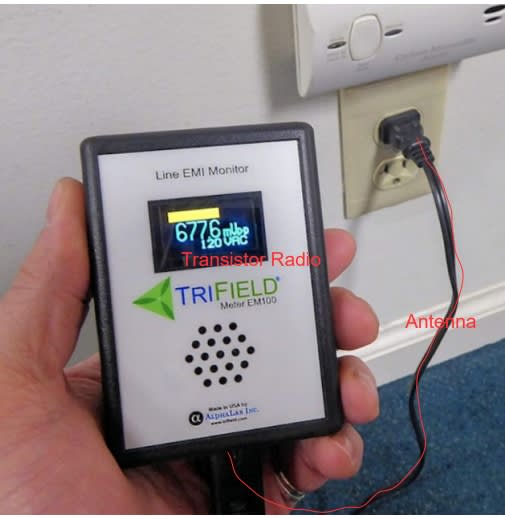I apologize for my flippant suggestion,partly.
I say partly because while I accept and recognize that your client has a real problem, I am still skeptical about the usefulness of the meter.
The first rule of trouble shooting is:
"Identify the root cause of the issue."
The second rule of trouble shooting is:
"Identify the root cause of the issue."
FacEngrPE said:
Likely the house wiring is acting as an antenna.
I agree that is a very strong possibility.
What does this mean?
The field is probably external.
We may install capacitors on individual circuits to get a "happy" meter reading but your client will still be subject to the external field.
If this is an induced voltage and you are successful in suppressing it at the main panel, the circuit conductors will still act as an antenna and you may still see a high reading at the receptacle. (And your client will still be subject to the electromagnetic field.
The Line EMI Meter measures electromagnetic interference (EMI) in a single-phase AC power line. It plugs into a wall outlet and does not require a battery.
That is unfortunate and limits the usefulness of the device.
If you are able to find a battery powered meter, connect 10 or 20 feet of wire to the device and trail it around the home.
Let's troubleshoot, but first a comment:
While your client is troubled by a meter indication of 1.4 Volts Peak to peak, does he realize that he is immersed in a very strong electromagnetic field driven by over 600,000 Milli-Volts peak to peak?
The first rule[/b] of trouble shooting is:
"Identify the root cause of the issue."
What is the issue?
"he has been experiencing a greater level of malaise over the past six months."
Fair enough.
Next step.
The second rule of trouble shooting is:
"Identify the root cause of the issue."
"Greater malaise."- Could be the weather, could be depression over political events, could be diet, and it could be an increased electromagnetic field.
Fair enough.
Let's examine the possibility of an increased electromagnetic field.
What can we do with the meter?
Take about 10 feet of single conductor and connect it CAREFULLY to the hot terminal of the meter.
See if this changes the reading.
Move the wire in a direction at right angles.
See if this changes the reading.
Get a step ladder and hang the wire as near vertical as possible.
See if this changes the reading.
Why are we doing this?
To determine if the circuit conductor is the source of the EMI or a receptor of the EMI.
If the circuit conductor is the source, the orientation of the test wire may have little effect on the meter reading.
If the circuit conductor is a receptor, the orientation of the test wire in the EMI field may affect the meter reading.
Do the test and hope for the best but know that the results may be inconclusive.
Do a test on the receptacle closest to the panel.
Then plug in an extension cord and with the cord as straight as possible, test with the meter at the end of the cord.
Route the cord in various directions and also vertically from the stepladder.
Markedly different readings on the meter are a strong indication that the EMI field is external.
The worst offenders in the house are the halogen 12v downlights.
I hope that the client has been able to rule these out as the source of the current issues.
Client has just informed me that the Line EMI monitor reading of 1400mV decreases to 1100 mV at night. Not sure if this is will be a useful clue or not.
This points to the solar system as a possible source.
It may still be power line conducted or a radiated field.
Power line conducted:
Try some capacitors to ground. DO NOT USE MOTOR STARTING CAPACITORS.
Motor starting capacitors are intended for short time use and will overheat and fail if connected continuously.
Capacitors may reduce or eliminate conducted EMI.
If the EMI is a radiated field, consider a Faraday shield.
call in a contractor for a quotation to cover the house with stucco.
Stucco is typically supported by either wire similar to chicken wire or by expanded metal.
Either one may be grounded thereby transforming the house into a Faraday shield.
Your client may paint the ceilings and cover the windows.
Note: the chicken wire like stucco wire may pass very short wavelength micro-waves.
The expanded metal not so much.
This is not my field either, but I have tried to go back to basic principles and hope that there are no "Unintended consequences" of which I am unaware.
--------------------
Ohm's law
Not just a good idea;
It's the LAW!

